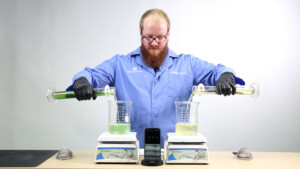English and Spanish subtitles are available.
In this video, we demonstrate the unique compatibility of our highly concentrated Super Phos® 0-50-0 product when mixed with calcium. In traditional fertilizers, when phosphorus and calcium are mixed they can precipitate and fall out of solution. The resulting calcium phosphate can clog drip emitters and damage sprayers.
Our Super Phos® product made with Micro Carbon Technology® will remain in solution.
Super Phos® with Micro Carbon Technology® aids in phosphorus uptake in high pH or calcareous soils and can be tank-mixed to improve availability of other phosphorus solutions. It resists “tie-up” with calcium or aluminum to remain water soluble and available to plant roots.
Related Posts

BHN Gilbert Building Dedication & Reception
On Wednesday, November 7th at 6:00 p.m., Bio Huma Netics will dedicate their new Gilbert Headquarters facility with a building dedication ceremony. Guests will hear remarks from Gilbert Mayor John Lewis and BHN President Lyndon Smith along with a ribbon cutting ceremony officially dedicating the building. Immediately following the building dedication will be an opportunity

Video: Super Phos + Calcium Mixing Stability Test
English and Spanish subtitles are available. In this video, we demonstrate the unique compatibility of our highly concentrated Super Phos® 0-50-0 product when mixed with calcium. In traditional fertilizers, when phosphorus and calcium are mixed they can precipitate and fall out of solution. The resulting calcium phosphate can clog drip emitters and damage sprayers. Our

The Road to Sustainability
“Sustainability is a way of thinking: At Huma® we’ve been thinking sustainably for over 50 years.” We make that statement at the top of the Sustainability section of our Huma® Website. And we stand by it. But what, exactly, does it mean? Over the past 50 years, we at Huma® have always striven to create products that work with nature in support of the well-being of our planet and our customers and to create a working environment that supports the well-being of our staff members and their families. We were doing this long before sustainability became the “thing” that it is now.

